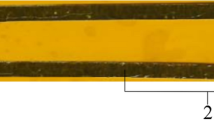Abstract
The effect of extended discontinuities in a hard rock mass on regularities of forming explosive fracture zones is considered. The comparison of the numerical and in situ experimental results permits to conclude that, in common with the known effect of seismic blast wave screenage, transformation of the wavefront configuration is of drastic importance. In a number of cases, that results in the generation of complex-structured fracture zones: new fractured zones can form beyond unbroken areas. It is demonstrated that the similar effects may cause redistribution of the blast energy and, as a consequence, the higher seismic efficiency produced by flat charge blasting as compared with concentrated charge blasting.
Similar content being viewed by others
References
V. N. Rodionov, V. V. Adushkin, V. N. Kostyuchenko, et al., Mechanical Effect of Underground Blasting [in Russian], Nedra, Moscow (1971).
G. G. Kocharyan and A. A. Spivak, Dynamics of Rock Mass Deformations [in Russian], IKTs Akademkniga, Moscow (2003).
V. V. Adushkin and A. A. Spivak, Geomechanics of Large-scaled Underground Blasting [in Russian], Nedra, Moscow (1993).
V. N. Oparin, A. A. Akinin, V. I. Vostrikov, and V. F. Yushkin, “Nonlinear deformation processes in the vicinity of mine workings. Part I,” Fiz.-Tekh. Probl. Razrab. Polezn. Iskop., No. 4 (2003).
V. N. Oparin, E. G. Balmashnova, and V. I. Vostrikov, “On dynamic behavior of “self-stressed block media. Part II: Comparison of theoretical and experimental data,” Fiz.-Tekh. Probl. Razrab. Polezn. Iskop., No. 5 (2001).
M. V. Kurlenya and V. N. Oparin, “Problems of nonlinear geomechanics. Part II,” Fiz.-Tekh. Probl. Razrab. Polezn. Iskop., No. 4 (2000).
V. N. Arkhipov, V. A. Borisov, A. M. Budkov, et al., Mechanical Effect of a Nuclear Explosion [in Russian], Fizmatlit, Moscow (2002).
G. Maenchen and E. Sack, “Tensor’ method of calculations,” in: Calculation Methods in Hydrodynamics [Russian translation], Mir, Moscow (1967).
B. V. Zamyshlyaev and L. S. Evterev, Models of Dynamic Deformation and Fracture of Soil Media [in Russian], Nauka, Moscow (1990).
Author information
Authors and Affiliations
Additional information
__________
Translated from Fiziko-Tekhnicheskie Problemy Razrabotki Poleznykh Iskopaemykh, No. 3, pp. 65–76, May–June, 2007.
Rights and permissions
About this article
Cite this article
Adushkin, V.V., Budkov, A.M. & Kocharyan, G.G. Features of forming an explosive fracture zone in a hard rock mass. J Min Sci 43, 273–283 (2007). https://doi.org/10.1007/s10913-007-0028-0
Received:
Issue Date:
DOI: https://doi.org/10.1007/s10913-007-0028-0



